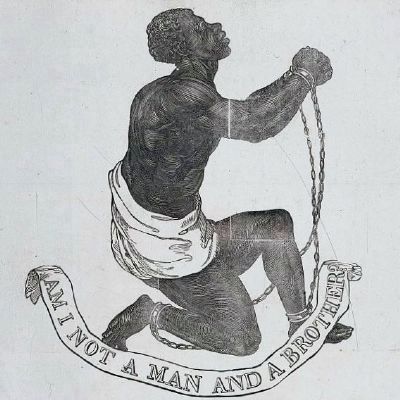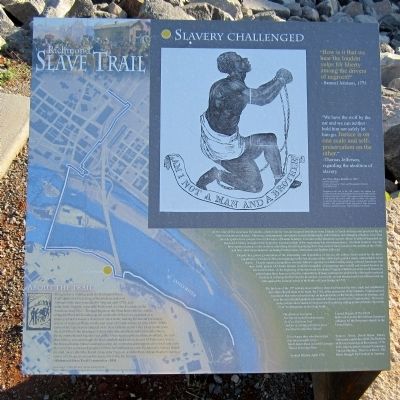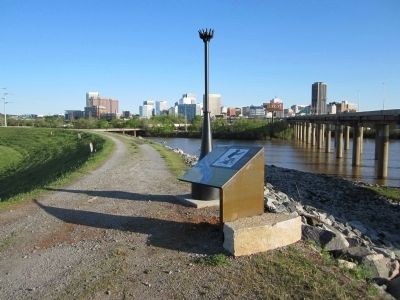Manchester in Richmond, Virginia — The American South (Mid-Atlantic)
Slavery Challenged
— Richmond Slave Trail —
“We have the wolf by the ear and we can neither hold him nor safely let him go. Justice is on one scale and self-preservation on the other.” - Thomas Jefferson, regarding the abolition of slavery
At the time of the American Revolution, chattel slavery was an accepted institution from Canada to South America and practiced by all thirteen American colonies. However, contemporary movements in moral philosophy and literature and changing religious views had already sparked new perspectives on the topic of human bondage; even successful plantation owners whose livelihood depended on enslaved Africans recognized the hypocrisy it posed in light of the impending war for independence. Northern Quakers were the first organized group to take action in abolishing slavery by purging their own sects of slave owners in the middle of the 1700s, and later other denominations including Presbyterians, Methodists and Baptists followed.
Despite this growing realization of the inhumanity and degradation of slavery, the culture clash created by the importation of enslaved Africans beginning in the last decades of the 1600s had created a nearly unbreachable racial chasm. Deeply ingrained prejudices towards Africans spurred on a belief among many colonial Americans that once freed, people of African descent would be incapable of integrating into society and instead become an economic burden. At the beginning of the American Revolution Virginia’s British governor, Lord Dunmore, played upon these fears as well as the vulnerability of many southern slaveholders by offering the enslaved freedom in exchange for their loyalty in combat. As a result, several hundred enslaved Africans took up arms against the colonial rebels at the Battle of Great Bridge in 1775.
By the turn of the 19th century, most northern states had banned the slave trade an established laws that allowed them to be freed. By 1782, at the persuasion of the Quakers, Virginia passed legislation that removed restrictions on manumission, or the freeing of those in bondage, and over the next decade hundreds of enslaved Africans were freed in Virginia alone. However, many owners chose instead to increase their wealth by selling enslaved blacks “down the river” to plantations in the Deep South.
The Battle of Lexington
For liberty each Freeman strives
As it’s a Gift from God
And for it, willing yield their Lives
And Seal in with their Blood.
Twice happy they who thus resign
Into the peaceful Grave
Much better those in Death Consign
Than a Surviving Slave
-Lemuel Haynes,

2. Am I Not a Man and a Brother, ca. 1789
woodcut print 1837, Library of Congress, Prints and Photographic Division, LC-USZC4-5321
Designed at the end of the 18th century, this emblem was commissioned by the British Quaker-led Society for Effecting the Abolition of the Slave Trade. Upon approval, the design became a seal used by the Society while cameo versions were shipped to America where they quickly became a fashionable symbol of abolition. This particular version appeared in John Greenleaf Whittier’s antislavery poem, “Our Countrymen in Chains.”
Designed at the end of the 18th century, this emblem was commissioned by the British Quaker-led Society for Effecting the Abolition of the Slave Trade. Upon approval, the design became a seal used by the Society while cameo versions were shipped to America where they quickly became a fashionable symbol of abolition. This particular version appeared in John Greenleaf Whittier’s antislavery poem, “Our Countrymen in Chains.”
Lemuel Haynes (1753-1833)
Believed to be the first African American ordained by the Protestant church in the United States.
Sources: Davis, David Brion, Emory University conference, 2008, The Problem of Slavery in the Age of revolution, 1770-1823, Slavery in the Colonial Chesapeake: Vincent Harding, There is a River: The Black Struggle for freedom in America.
About the Trail
Designed as a walking path, the Richmond Slave Trail chronicles the history of the trade in enslaved Africans from their homeland to Virginia until 1778, and away from Virginia, especially Richmond, to other locations in the Americas until 1865. The trail begins at the Manchester Docks, which, alongside Rocketts Landing on the north side of the river, operated as a major port in the massive downriver slave trade, making Richmond the largest source of enslaved blacks on the east coast of America from 1830 to 1860. While many of the slaves were shipped on to New Orleans and to other Deep South ports, the trail follows the footsteps of those who remained here and crossed the James River, often chained together in a coffle. Once reaching the northern riverbank, the trail then follows a route through the slave markets and auction houses of Richmond, beside the Reconciliation Statue commemorating the international triangular slave trade and on to the site of the notorious Lumpkin’s Slave Jail and leading on to Richmond’s African Burial Ground, once called the Burial Ground for Negroes, and the First African Baptist Church, a center of African American life in pre-Civil War Richmond. - Richmond Slave Trail Commission – 2011 –
Title image: “After the Sale: Slaves Going South”, 1853, Painted from live by Eyre Crowe, courtesy the Chicago History Museum
Erected 2011 by Richmond Slave Trail Commission. (Marker Number 6.)
Topics and series. This historical marker is listed in these topic lists: Abolition & Underground RR • African Americans • Churches & Religion • Industry & Commerce. In addition, it is included in the Quakerism series list. A significant historical year for this entry is 1775.
Location. 37° 31.543′ N, 77° 25.74′ W. Marker is in Richmond, Virginia. It is in Manchester. Marker can be reached from the intersection of Maury Street and Brander Street. human trafficking. Touch for map. Marker is in this post office area: Richmond VA 23224, United States of America. Touch for directions.
Other nearby markers. At least 8 other markers are within walking distance of this marker. Native Markets (approx. 0.2 miles away); Water Quality in the James (approx. 0.3 miles away); Here Stood the Trigg Shipyard (approx. 0.3 miles away); Transitions (approx. 0.4 miles away); Libby Prison (approx. 0.4 miles away); Richmond Dock / Chapel Island (approx. 0.4 miles away); Creole Revolt (approx. 0.4 miles away); The Tidal James (approx. 0.4 miles away). Touch for a list and map of all markers in Richmond.
Credits. This page was last revised on February 1, 2023. It was originally submitted on April 19, 2011, by Bernard Fisher of Richmond, Virginia. This page has been viewed 935 times since then and 43 times this year. Photos: 1, 2, 3. submitted on April 19, 2011, by Bernard Fisher of Richmond, Virginia.

